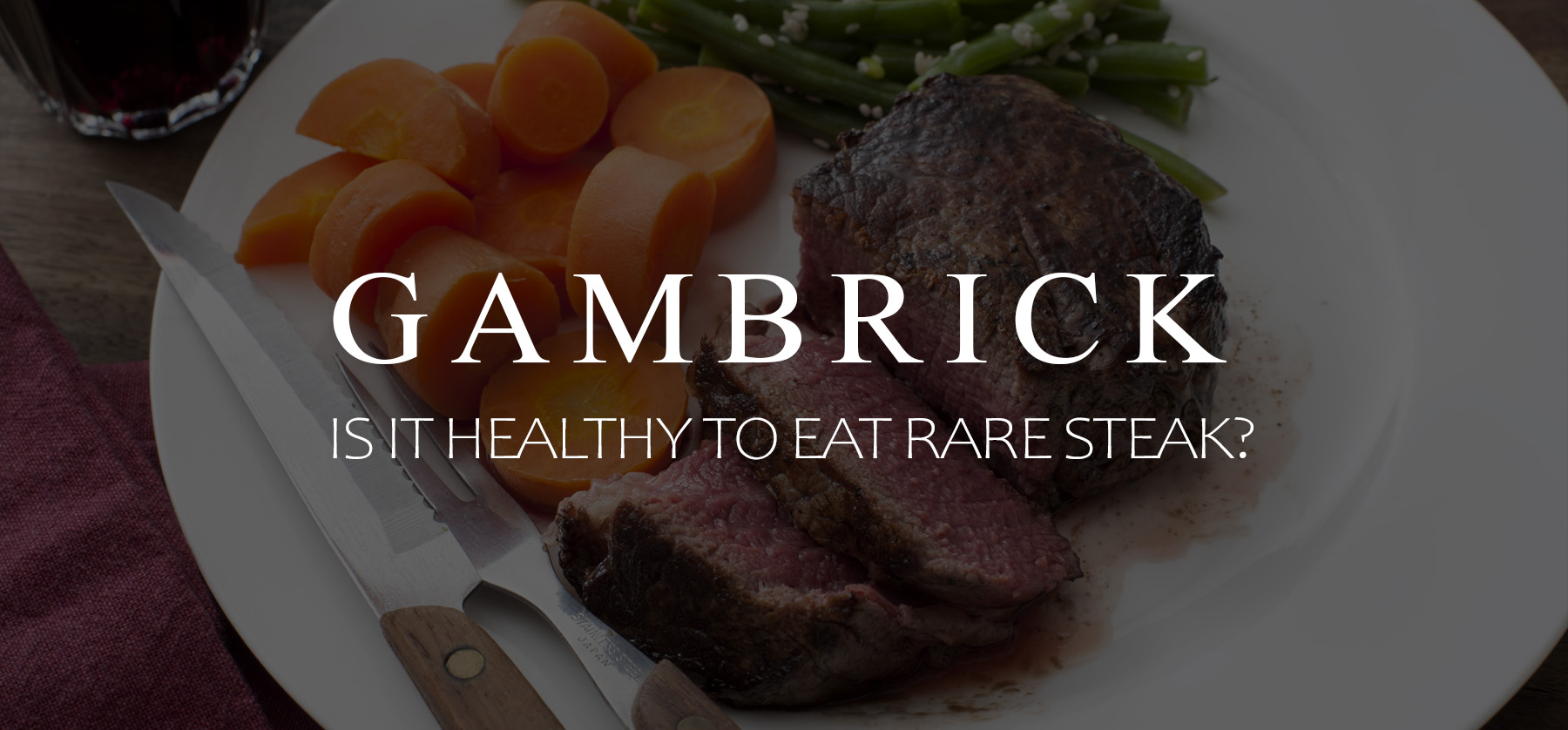Is It Healthy To Eat Rare Steak?
The most popular way people eat steak is medium-rare and rare. A rare steak is generally considered more tender and flavorful. As steak is cooked to higher internal temperatures, it starts to dry out and become tougher. In addition to better flavor and texture, it can be healthy to eat rare steak. Most chefs agree that red meat should not be overcooked. It tends to get tough, chewy, and flavorless. But it needs to be cooked properly. Eating steak that’s under-cooked can cause illness. Rare steak is beef that’s cooked to an internal temperature of at least 125° Fahrenheit (52° C). Meat should always be checked with a meat thermometer to make sure it’s the correct temperature before eating.
There are several health benefits associated with eating rare steak. Consuming rare steak can lower cholesterol, fight fatigue, strengthen your immune system, promote muscle growth, and help you lose weight.
Many people are cautious about ordering or cooking rare steak. If it’s too rare the meat can be dangerous to eat. When at home, cook meat that’s as fresh as possible because there’s less chance for bacterial growth. Use a food thermometer to check the internal temperature of the meat. As long it reaches 125° Fahrenheit (52° C) it’s safe to eat. When eating out, inspect the thickest part of the meat. It shouldn’t be cool or blueish purple inside. The juices should be pinkish or clear and not bright red.
Eating rare steak can be a healthy addition to the diet when cooked properly.
Is Eating Rare Steak Healthy?
Eating rare steak can be a healthy addition to the diet. Cooking beef not only makes meat tougher but also less flavorful and in some cases less nutritious.
There are several health benefits associated with eating rare beef which we’ll discuss below.
Eating Rare Steak May Help Lower Cholesterol
Grass-fed beef contains Omega-3 fatty acids. The rarer the steak the more of these fatty acids you can potentially absorb. Essential fatty acids help lower cholesterol and may reduce the risk of heart disease.
Consuming Omega-3 fatty acids may also help with a few other important health issues such as:
- Help fight depression and anxiety
- Lower blood pressure
- Improve eye health
- Fight inflammation
- Reduce triglycerides
- Brain function
- Slow the development of plaque in the arteries
- Weight loss
- Reduce the chance of abnormal heart rhythm
- Good for joint health
- Reduce the likelihood of heart attack and stroke
- Lessen the chance of sudden cardiac death in people with heart disease
Many people take Omega-3 supplements because of all the potential health benefits. However, you can get Omega-3s simply by eating rare steak.
Eating Rare Steak Fights Fatigue
Eating rare steak contains the minerals iron and phosphorus. Both of which are helpful for preventing fatigue.
The iron found in rare meat increases the oxygen in your blood while phosphorus provides strength for your bones.
Carbohydrates with simple sugars can give you fast energy by creating an insulin spike in your body. however, that spike is generally followed by a crash which leaves you feeling fatigued. A diet higher in rare meat and complex carbs provided by fruits and vegetables gives you steady energy all day without the crash.
Rare Steak Strengthens The Immune System
Rare meat contains plenty of zinc and protein which are nutrients your body needs for a healthy immune system. In fact, steak is a complete meal with just about everything a body needs. When you eat steak, or other meats, on a regular basis as part of an overall healthy diet, you don’t need to rely as much on supplementation.
Building a healthy immune system stems from a healthy diet and lifestyle. Because rare steak has so many essential nutrients and proteins, a diet that includes them is more complete. It’s easier to follow a diet that include rare beef because you don’t have to consume as many other food or supplements to get the nutrition you need.
Eating Rare Steak Improves Hair & Nail Health
Rare steak contains high amounts of vitamin B12 as well as many other essential nutrients and proteins.
Vitamin B12 increases collagen production in your body and contributes to the growth and health of hair and nails. This can help strengthen both your hair and nails.
Rare steak is packed with essential complete proteins which also helps both hair and nail health and growth. Protein is used inside the body to both repair damage and grow new tissue. It’s an essential part of a healthy lifestyle and easy to come by if you eat beef.
The Dangers Of Eating Rare Meat
The primary danger of eating rare meat is sickness caused by bacteria. Cooking meat to an internal temperature of at least 125° Fahrenheit (52° C) kills harmful bacteria. This is considered Rare. Any cooler and bacteria may still be present when you eat the meat.
When cooking rare meat at home, always check the thickest part of the cut with a meat thermometer. It’s the only way to verify the meat’s internal temperature.
I’ve written an entire post detailing how rare is too rare for steak.
Checking meat by eye or touch isn’t the most reliable way to determine if steak is cooked properly. But here are a few things you should look out for.
- Cool center
- Blueish or purple coloring in the center
- Bright red juices
- Under-cooked outside
A rare piece of steak should have clear or pinkish juices and not bright red. The inside should not be cold. And the color should be red and not blueish or purple.
Is It Safe To Eat A Rare Steak?
A steak that’s cooked to at least medium-rare has reached an internal temperature that’s safe to eat. However, if you prefer your steak rare, there’s a slightly higher risk of illness due to ingesting bacteria. The rarer the meat, the higher the risk. But rare steak is still one of the most popular ways people cook steak.
It’s perfectly safe to eat a rare steak as long as it’s been cooked properly. Since eating rare meat has a higher chance of bacteria, you need to eat it very fresh. The fresher the beef the better.
When you cook a rare steak at home, I recommend buying from a butcher. They generally have the freshest beef. Buy it the same day you plan to cook so there’s less time sitting in a fridge. Always use a meat thermometer to check the internal temperature of the meat.
Rare steak has to be at least 125° Fahrenheit (52° C) in the center of the cut.
If you’re eating out, choose a high-quality and reputable steak house or restaurant. The chef will know how to cook a rare steak with the proper internal temperature. Some high-end restaurants will even serve raw beef such as steak tartar because they have the skill and expertise to do it.
There are a few things you can check on your own. A rare steak should be red on the inside but not blueish or purple. The inside should not be cool or cold. Juices running from the beef should be clear or pinkish but not bright red.
If steak is cooked properly to the correct internal temperature, bacteria should be killed which makes the steak safe to eat.
Why Is It Safe To Eat Rare Steak?
The reason why it’s perfectly safe to eat rare steak is because the bacteria has been killed. Rare steak is defined as having an internal temperature of at least 125° Fahrenheit (52° C). This temperature is hot enough to kill bacteria that may be living in or on the meat. Which means the beef is safe to eat.
There’s actually no danger in eating completely raw beef if it contains no bacteria. It’s the bacteria present on the meat that can make you sick, not the beef itself. Cooking the meat kills the bacteria so there’s no danger.
However, you have to cook beef to at least 125° Fahrenheit (52° C) to be sure. The rarer the meat the riskier eating it becomes.
The most popular way people eat steak is medium-rare. At this temperature, beef still has great texture and taste but it’s safer to eat and not bloody.Here’s a breakdown of how American generally cook and/or order steak.
- 2% of Americans cook steak burnt which is beyond well-done
- 2% like their steak blue-rare
- 12% eat steak rare
- 30% medium rare
- 13% medium,
- 16% medium well
- 25% well done
Eating rare steak is perfectly safe, as long as you avoid cross contamination. This is why proper handling is so important. Even if you cook rare steak to the correct internal temperature, you can still contaminate the steak later by touching a utensil, knife or surface that contains bacteria.
Safe Meat Preparation
The first step when cooking steak is safe preparation. make sure your cook area, utensils, knives and equipment are all clean and disinfected. Any surface, tool or piece of equipment that comes in contact with the meat needs to be clean and free of bacteria. I use an anti-bacterial soap and a damp sponge to wipe down all my surfaces, tools and equipment.
If meat’s been in the freezer or fridge, let it thaw before cooking. Beef should be about room temperature when you cook it.
There are different ways to cook a steak. it can be grilled, fried or cooked in an oven. No matter which method you choose, the internal temperature still has to reach a minimum of 125° Fahrenheit (52° C) for rare steak to be safe for consumption.
Once the meat reaches the proper internal temperature for the type of steak you like, take it off the heat and let it sit. Steak should rest for about 5 minutes after it’s been cooked. This time allows the juices to flow throughout the meat.
Any surface, knife and utensil that touched the raw beef should not touch it again after it’s been cooked unless it’s been thoroughly cleaned. Even though the beef has been cooked hot enough to kill bacteria, you can cross contaminate it with an item that contains bacteria. And this includes your own hands.
Be very careful when handling raw meat because cross contamination is easy to do.
Levels Of Steak Doneness
Cooking steak alters it’s color and texture. An experienced chef can tell how well a steak is cooked just by looking at it and/or touching it. However, the only reliable method the know for sure if a rare steak is cooked well enough to safely eat is by using a meat thermometer.
A meat thermometer will tell you the internal temperature of the steak. As long as the center of the fattest piece of meat is at least 125° Fahrenheit (52° C), it’s safe to eat.
So, what does steak look like at different levels of doneness?
- Blue steak: Cooked for just 90 seconds on each side. It has a blueish or purple inside that’s relatively cool to the touch. Blue steak is practically raw.
- Rare steak: Each side should be cooked for around two minutes and 15 seconds. Slight spongy resistance to touch with a dark red and juicy center.
- Medium-rare: Cook for three minutes and 15 seconds on each side. Has some flowing juices with a pink center and slight spring to touch.
- Medium: Cook for four and a half minutes on each side. Pale pink inside with little juices.
- Well-done: Each side should be given around five minutes on each side. Very little pink or none at all. Still moist but not very juicy.
Remember how the weight and size of your steak cut effects the cooking time. The times listed above are for the average size 3.5 cm thick cut.
Cooking times should be altered for thinner or thicker cuts of beef. However, thickness does not change the fact that a rare steak needs to have an internal temperature of at least 125° Fahrenheit (52° C) to be considered safe to eat.
Does Rare Steak Have Blood?
There may be small amounts of blood in rare steak. However, the red you see in rare meat is actually not blood. It’s mostly made of fat, water, and Myoglobin. It’s a protein found in muscle tissue that causes the red coloring in meat. Even when served rare, a high quality cut of steak that’s been properly butchered and drained should have very little blood.
What Happens Of You Eat Steak Too Rare?
Eating steak that’s too rare increase the chance you could ingestion bacteria like salmonella, which causes abdominal cramps, fever, and watery diarrhea. If untreated, bacteria can then spread from your intestines to other parts of your body such as bones, joints, and bloodstream.
Just because meat is very rare or raw doesn’t mean it contains bacteria. Some restaurants will serve beef that’s totally raw which is called steak tartar. If there’s no bacteria then eating raw meat is safe. However, it’s much safer if you cook the meat to be sure. I would not recommend eating raw meat unless it’s been prepared by a professional. And even in that case it’s a risk.
Cooking beef kills bacteria. This is why rare steak needs to reach an internal temperature of at least 125° Fahrenheit (52° C) to be considered safe to consume. At that temperature all bacteria living in or on the meat will be killed.
The internal temperature of beef should be checked with a meat thermometer at the cuts thickest area. Find the thickest part of the steak and insert the thermometer to it’s center. If the temperature is below 125° Fahrenheit (52° C), keep cooking.
Summary: Is It Healthy To Eat Rare Steak?
The most popular way people eat steak is medium-rare and rare. A rare steak is generally considered more tender and flavorful. As steak is cooked to higher internal temperatures, it starts to dry out and become tougher. In addition to better flavor and texture, it can be healthy to eat rare steak. Most chefs agree that red meat should not be overcooked. It tends to get tough, chewy, and flavorless. But it needs to be cooked properly. Eating steak that’s under-cooked can cause illness. Rare steak is beef that’s cooked to an internal temperature of at least 125° Fahrenheit (52° C). Meat should always be checked with a meat thermometer to make sure it’s the correct temperature before eating.
There are several health benefits associated with eating rare steak. Consuming rare steak can lower cholesterol, fight fatigue, strengthen your immune system, promote muscle growth, and help you lose weight.
Many people are cautious about ordering or cooking rare steak. If it’s too rare the meat can be dangerous to eat. When at home, cook meat that’s as fresh as possible because there’s less chance for bacterial growth. Use a food thermometer to check the internal temperature of the meat. As long it reaches 125° Fahrenheit (52° C) it’s safe to eat. When eating out, inspect the thickest part of the meat. It shouldn’t be cool or blueish purple inside. The juices should be pinkish or clear and not bright red.
Eating rare steak can be a healthy addition to the diet when cooked properly.
If you have any questions about cooking steak, email any time.





















